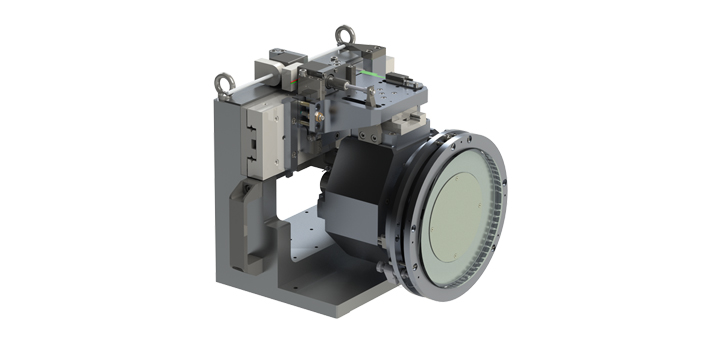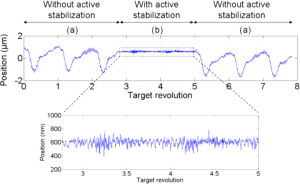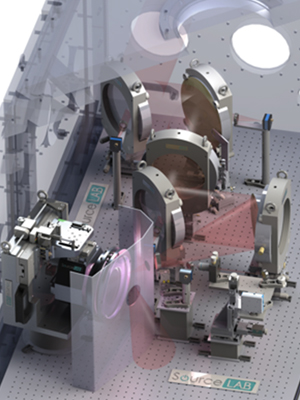TARGETRY
Your tool for laser-solid interaction

The SL-ST-1000 system
The SourceLAB Solid Target is a motorized mechanical assembly conceived for the interaction of a high-intensity laser with a solid target at very high repetition rate, up to several kHz.
This system can be used for plasma mirror contrast cleaning and high energy particle or radiation generation, such as sub-femtosecond XUV pulses, electron or proton beam acceleration.
Ultra-high positioning precision
(< 2 µm PTV and < 100 nm with active stabilization)
Rotation velocity > 720 °/s
(adapted to kHz interaction)
Fully interfaced and easy to align

The SL-ST-1000 system
The SourceLAB Solid Target is a motorized mechanical assembly conceived for the interaction of a high-intensity laser with a solid target at very high repetition rate, up to several kHz.
This system can be used for plasma mirror contrast cleaning and high energy particle or radiation generation, such as sub-femtosecond XUV pulses, electron or proton beam acceleration.
Ultra-high positioning precision
(< 2 µm PTV and < 100 nm with active stabilization)
Rotation velocity > 720 °/s
(adapted to kHz interaction)
Fully interfaced and easy to align
Designed to offer perfectly reproducible interaction conditions
Even for the tightest focusing, the rotating target surface is precisely and easily aligned with the rotation axis.
As a consequence, without active stabilization, target surface residual motion is limited to 2 µm Peak-to-Valley and maintains the surface of interaction within the Rayleigh length of the incoming laser beam.
With active stabilization in option, the residual motion is lower than 100 nm PTV.

Positioning precision measurement of the SL-ST-1000
Even for the tightest focusing, the rotating target surface is precisely and easily aligned with the rotation axis.
As a consequence, without active stabilization, target surface residual motion is limited to 2 µm Peak-to-Valley and maintains the surface of interaction within the Rayleigh length of the incoming laser beam.
With active stabilization in option, the residual motion is lower than 100 nm PTV.

Positioning precision measurement of the SL-ST-1000
Perfect for plasma-mirroring

Example of plasma mirror setup based on the SL-ST-1000 target
Excellent laser contrast is a key parameter to enable laser-plasma interaction.
SourceLAB is specialized in designing systems and beamlines providing perfect interaction conditions to experimentalists.
With its precise positioning, and compatibility with high repetition rates (up to several kHz), the SL-ST-1000 is a unique component for a state-of-the-art plasma mirror setup.
SourceLAB can manage all of the aspects of the design of such a complex equipment, from physics to integration.
Examples of plasma mirrors designed by SourceLAB based on the SL-ST-1000 target:
LOA new “Salle Noire”
3 fs, 5-10 mJ
1 kHz
ELI-ALPS SHHG beamline
2 PW (17 fs, 34 J)
10 Hz
Detailed specifications:
Residual motion after alignment: < 2 µm
Dimensions: 350 x 250 x 340 mm
Mass: ~ 8 kg
TRANSLATION X
Motor type: Stepper motor
Range: 200 mm
Encoder: Yes
Minimal incremental motion: 0.1 µm
Rectitude: 2 µm
Maximum velocity: 15 mm/s
ROTATION
Motor type: Torque motor
Range: 360°
Encoder: Yes
Minimal incremental motion: 1°
Intrinsic wobble: <10 µrad
Maximum velocity: Up to 720 °/s
WOBBLE CORRECTION
Motor type: Picomotors actuators
Range: 12,5 mm
Encoder: No
Resolution: 30 nm
Maximum velocity: 0.5 mm/s
No download available.
- S. Haessler et al.
High-Harmonic Generation and Correlated Electron Emission from Relativistic Plasma Mirrors at 1 kHz Repetition Rate
Ultrafast Science, 9893418 (2022)
- F. Böhle et al.
Generation of XUV spectral continua from relativistic plasma mirrors driven in the near-single-cycle limit
Journal of Physics: Photonics, 2, 034010 (2020)
- N. Zaim et al.
Few-cycle laser wakefield acceleration on solid targets with controlled plasma scale length
Physics of Plasmas, 26, 033112. (2019)
- M.Bocoum et al.
Anticorrelated Emission of High Harmonics and Fast Electron Beams From Plasma Mirrors
Phys. Rev. Lett. 116, 185001 (2016)
- M. Bocoum et al.
Spatial-domain interferometer for measuring plasma mirror expansion
Optics Letters, Vol. 40, Issue 13, pp. 3009-3012 (2015)
- A. Borot et al.
High repetition rate plasma mirror device for attosecond science
Review of Scientific Instruments, Volume 85, Issue1, 013104, January (2014)
- J. Wheeler et al.
Attosecond lighthouses from plasma mirrors
Nature Photonics, Volume 6, N° 12, pp. 829-833, December (2012)
- A. Borot et al.
Attosecond control of electron motions in plasmas
Nature Physics, Volume 8, N° 5, pp. 416-421, May (2012)
- A. Borot et al.
High-harmonic generation from plasma mirrors at kilohertz repetition rate
Optics Letters, Volume 36, Issue 8, pp. 1461 – 1463, April (2011)
- Overview
-
Your tool for laser-solid interaction

The SL-ST-1000 system
The SourceLAB Solid Target is a motorized mechanical assembly conceived for the interaction of a high-intensity laser with a solid target at very high repetition rate, up to several kHz.
This system can be used for plasma mirror contrast cleaning and high energy particle or radiation generation, such as sub-femtosecond XUV pulses, electron or proton beam acceleration.
Ultra-high positioning precision
(< 2 µm PTV and < 100 nm with active stabilization)Rotation velocity > 720 °/s
(adapted to kHz interaction)Fully interfaced and easy to align

The SL-ST-1000 system
The SourceLAB Solid Target is a motorized mechanical assembly conceived for the interaction of a high-intensity laser with a solid target at very high repetition rate, up to several kHz.
This system can be used for plasma mirror contrast cleaning and high energy particle or radiation generation, such as sub-femtosecond XUV pulses, electron or proton beam acceleration.
Ultra-high positioning precision
(< 2 µm PTV and < 100 nm with active stabilization)Rotation velocity > 720 °/s
(adapted to kHz interaction)Fully interfaced and easy to align
Designed to offer perfectly reproducible interaction conditions
Even for the tightest focusing, the rotating target surface is precisely and easily aligned with the rotation axis.
As a consequence, without active stabilization, target surface residual motion is limited to 2 µm Peak-to-Valley and maintains the surface of interaction within the Rayleigh length of the incoming laser beam.
With active stabilization in option, the residual motion is lower than 100 nm PTV.

Positioning precision measurement of the SL-ST-1000
Even for the tightest focusing, the rotating target surface is precisely and easily aligned with the rotation axis.
As a consequence, without active stabilization, target surface residual motion is limited to 2 µm Peak-to-Valley and maintains the surface of interaction within the Rayleigh length of the incoming laser beam.
With active stabilization in option, the residual motion is lower than 100 nm PTV.

Positioning precision measurement of the SL-ST-1000
Perfect for plasma-mirroring

Example of plasma mirror setup based on the SL-ST-1000 target
Excellent laser contrast is a key parameter to enable laser-plasma interaction.
SourceLAB is specialized in designing systems and beamlines providing perfect interaction conditions to experimentalists.
With its precise positioning, and compatibility with high repetition rates (up to several kHz), the SL-ST-1000 is a unique component for a state-of-the-art plasma mirror setup.
SourceLAB can manage all of the aspects of the design of such a complex equipment, from physics to integration.
Examples of plasma mirrors designed by SourceLAB based on the SL-ST-1000 target:
LOA new “Salle Noire”
3 fs, 5-10 mJ
1 kHzELI-ALPS SHHG beamline
2 PW (17 fs, 34 J)
10 Hz - Specifications
-
Detailed specifications:
Residual motion after alignment: < 2 µm
Dimensions: 350 x 250 x 340 mm
Mass: ~ 8 kgTRANSLATION X
Motor type: Stepper motor
Range: 200 mm
Encoder: Yes
Minimal incremental motion: 0.1 µm
Rectitude: 2 µm
Maximum velocity: 15 mm/sROTATION
Motor type: Torque motor
Range: 360°
Encoder: Yes
Minimal incremental motion: 1°
Intrinsic wobble: <10 µrad
Maximum velocity: Up to 720 °/sWOBBLE CORRECTION
Motor type: Picomotors actuators
Range: 12,5 mm
Encoder: No
Resolution: 30 nm
Maximum velocity: 0.5 mm/s - Downloads
-
No download available.
- Publications
-
- S. Haessler et al.
High-Harmonic Generation and Correlated Electron Emission from Relativistic Plasma Mirrors at 1 kHz Repetition Rate
Ultrafast Science, 9893418 (2022)
- F. Böhle et al.
Generation of XUV spectral continua from relativistic plasma mirrors driven in the near-single-cycle limit
Journal of Physics: Photonics, 2, 034010 (2020)
- N. Zaim et al.
Few-cycle laser wakefield acceleration on solid targets with controlled plasma scale length
Physics of Plasmas, 26, 033112. (2019)
- M.Bocoum et al.
Anticorrelated Emission of High Harmonics and Fast Electron Beams From Plasma Mirrors
Phys. Rev. Lett. 116, 185001 (2016)
- M. Bocoum et al.
Spatial-domain interferometer for measuring plasma mirror expansion
Optics Letters, Vol. 40, Issue 13, pp. 3009-3012 (2015)
- A. Borot et al.
High repetition rate plasma mirror device for attosecond science
Review of Scientific Instruments, Volume 85, Issue1, 013104, January (2014)
- J. Wheeler et al.
Attosecond lighthouses from plasma mirrors
Nature Photonics, Volume 6, N° 12, pp. 829-833, December (2012)
- A. Borot et al.
Attosecond control of electron motions in plasmas
Nature Physics, Volume 8, N° 5, pp. 416-421, May (2012)
- A. Borot et al.
High-harmonic generation from plasma mirrors at kilohertz repetition rate
Optics Letters, Volume 36, Issue 8, pp. 1461 – 1463, April (2011)
- S. Haessler et al.